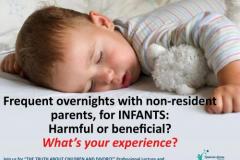All posts
Custody Arrangements for Very Young Children
Recently, I have found myself thinking a lot about the best, and the worst, custody arrangements for very young children. When I say very young children, I am thinking about infants (aged newborn to roughly 18 months) as well as toddlers (aged 18 months to about 3 years). Below, I will offer some of my […]


Recently, I have found myself thinking a lot about the best, and the worst, custody arrangements for very young children. When I say very young children, I am thinking about infants (aged newborn to roughly 18 months) as well as toddlers (aged 18 months to about 3 years).
Below, I will offer some of my own thoughts about this very important, and it seems, increasingly controversial topic. But at the outset, I want to invite readers to share their experiences about what is working for you, and what isn’t; about what custody arrangements you have chosen for your own very young children, and about what schedules were imposed on you by a court, an ex, whoever.
I am looking for your input, because I have been hearing more and more from parents who are very unhappy about parenting plans for their very young children. Mostly, I have been getting emails or telephone calls from parents, usually mothers, who are scared to death that their very young child has been divided – and is being damaged both now and in the long term. I also have heard from other parents, mainly fathers, who are afraid they are being shut out of their very young children’s lives – now and for the long run.
There are a lot of complicated psychological, practical, and legal issues involved in custody arrangements for very young children. I will not delve very deeply into the details in this post, or I will end up going on for too long. Look for future posts with more specifics.
Psychologically, the quality of attachment relationships is the main concern about the well-being of very young children. Children form a close bond with those who care for them, usually their parents, in the first year of life (and beyond). The development of attachments is a biologically driven process, one that is observed in other primates, other mammals, and precocial birds. (Think of ducklings swimming in line behind their mother on a pond in springtime.)
Very young children can and do form multiple attachments, including to mothers, fathers, grandparents, nannies, and so on. Still, children have a primary attachment figure, the person they prefer to offer them comfort in times of anxiety or pain. (A daycare worker can comfort a distraught toddler when no parent is available, but given a choice, an 18 month old will run to Mommy – or Daddy.)
Now we are getting to the nub of one controversy. A great deal of psychological research shows that the quality of the primary attachment – particularly whether it is secure or insecure – in very young children predicts the development of various psychological and social problems in the future. (Importantly, attachment is a central concern not only for custody but for other issues like day care, families where both parents are employed for long hours, hospitalized premature infants, incarcerated parents, and a variety of other issues involving parents’ relationships with their very young children.)
So in disputed custody cases, parents, lawyers, and various experts can and do end up debating whether a very young child’s primary attachment (usually to the mother) is all-important and pretty fragile – or whether their secondary attachment (usually to the father) is just as important and perhaps is being undermined, maybe deliberately, by a doting or vindictive primary attachment figure. Specific questions and debates range from whether babies, or toddlers, should have overnights with their secondary attachment figures to whether parents should share joint physical custody of infants, alternating back and forth every day if necessary.
I won’t go into the details now, but I clearly come down on the side of the importance of the primary attachment figure to children’s emotional well-being. Why? I am convinced by the weight of the scientific evidence.
Yet, both for practical and scientific reasons, I believe that it is very important for children to form attachment relationships with their “other” parent too.
If parents can work together, there are ways to achieve both goals. The secondary attachment figure can have frequent but relatively brief contacts with their baby during the first year of life, but the contacts can increasingly become longer and less frequent as babies become toddlers, preschoolers, and so on. (I’ve written about these developmental ideas at length in The Truth about Children and Divorce, and will expand upon them here in another post.)
But a lot of separated parents of very young children do not get along very well. And many separated parents are not encouraged (repeatedly and forcefully) by professionals about the overriding importance of working together for their children’s sake, no matter how hurt or angry the parents might justifiably be. And the legal system encourages parents of very young children to fight, because they will give away their “rights” if they compromise now. (More on this later too.)
As a result of all of this, legal, scientific, and, most importantly, family controversies erupt. This is a huge, and I think, growing problem. And I haven’t even touched on other issues, for example, the practical problems involved in shifting babies between households, or “expert opinion” that may be anything but.
What I am looking for are readers’ opinions and especially your experiences. (I know the motivation is greater to write about bad experiences; please share good ones too.) Family change and an interventionist legal system have put us into uncharted waters. I am looking for some help in mapping them.
**********************
Robert E. Emery, Ph.D. is a Professor of Psychology and well regarded international practice-based researcher. His research about the often overlooked, intense emotional cost of separation and divorce for children and parents is extensively cited around the world.
In July, we are honoured to be hosting Dr Emery on a tour of Queensland, to give a series of lectures, including the 15/16 July 2014 in Brisbane, entitled “The Truth About Children and Divorce.” Not afraid of controversy, Dr Emery will invite you to discuss his research on topics including infant overnights, randomised trials of mediated and litigated child custody disputes, and coparenting conflict and attachment.
Dr Emery’s explanation of high emotion, especially anger, has helped many family mediators deal with emotion in the room and also to understand how the length of separation affects and predicts behavior. The connection between how adults handle their emotions at separations and the effects on their children is the key Dr Emery can use to unlock many puzzles for mediators, family lawyers and other workers in the separation field.
Blog post originally published on August 23, 2011 by Robert E. Emery, Ph.D.
Back to all posts